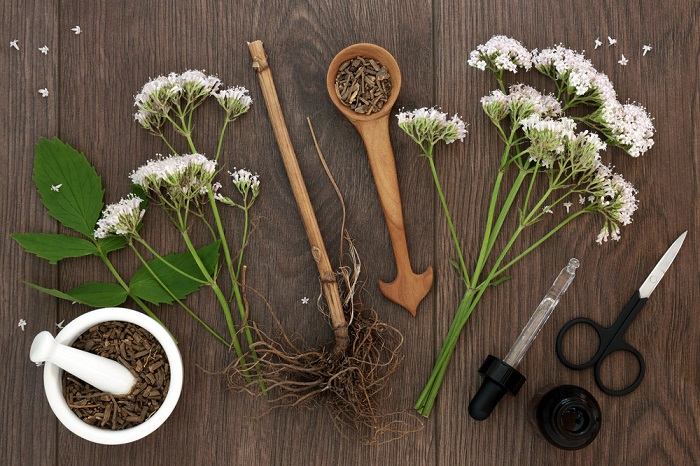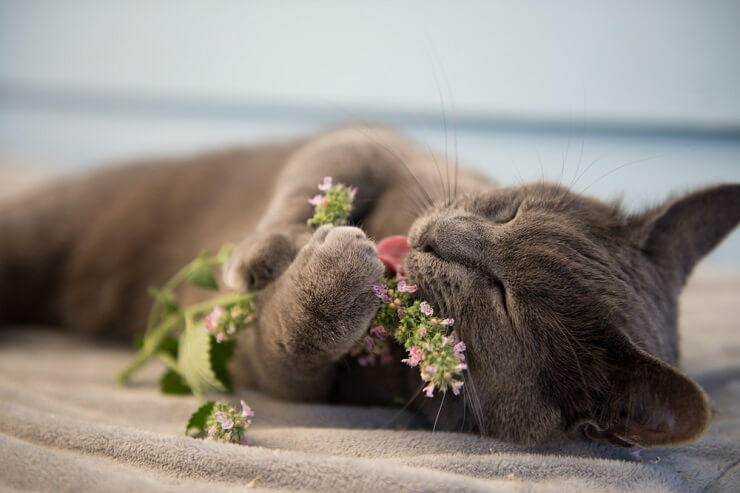
Most pet owners are familiar with the adorable sight of their cat rolling about in catnip and the reaction they seem to have to it afterward. The usual behavior includes your cat looking spaced out or vacant.
Key Takeaways
Although many cats love catnip, all cats react to it slightly differently and some cats don't react to it at all.
Catnip releases a chemical called nepetalactone that targets "happy" receptors in cats' brains and makes them feel euphoric.
Some cats roll in catnip and rub themselves in it, while others chew and swallow it.
Cats might become super affectionate and want lots of cuddles and attention. They might suddenly become very giddy and start playing with their toys wildly. Only cats—including big species and domestic cats—seem to be affected by catnip. What is it about catnip that is so special?
What Is Catnip?
Catnip, or Nepeta cataria, is a herb commonly found all over the world. It is native to Europe, the Middle East, and Asia, and it has become naturalized in North America and New Zealand. Catnip is sometimes referred to as catmint, catswort, or cat wort. It belongs to the Lamiaceae family.
Other famous herbs belonging to this family include mint, basil, oregano, and thyme. Catnip is often used by humans as well because it has relaxing properties when ingested. Catnip is found in certain herbal remedies and herbal drinks.
The catnip plant is perennial and if left to its own devices, it can grow into a beautiful large bush with purple white, or pink flowers. Bees and butterflies are attracted to it. It is known to have some insect-repellent properties, too, which make it an attractive option for gardeners to use in their vegetable crops to deter pests from ruining the crop. Ironically, because it is a prolific plant, some people consider it a weed.
Catnip is unique in that it contains an active compound called nepetalactone. This chemical has an effect on our cats in a few special ways. Nepetalactone causes cats to experience an overwhelming sense of euphoria.
We think that catnip targets receptors in the cat’s brain that make your cat feel happy and euphoric. This is due to the fact that it is a very similar-shaped molecule to some of the pheromones released by cats when they are ready to mate.
In a roundabout way, it can make cats feel like they are sexually stimulated. This affects cats whether they have been neutered or not. It’s not just our domestic cats that are affected by catnip. Big cats in the wild are, too. This includes tigers, lions, bobcats, and lynxes.
Evolutionary Reasons Why Cats Like Catnip

No one knows for sure, but it’s possible that rolling catnip protects wild cats from insects and overpowers their own scent to help with hunting.
There are two theories as to why cats are programmed to be attracted to catnip
1. Cats in the wild would benefit from the pest-repelling properties of catnip. It is thought that when cats paw at and play with the catnip leaves, molecules called iridoids are released. This covers the cat in an insect-repelling substance.
If cats have recently rolled in catnip, they will have been less likely to have parasite infections from mites and insects, or be bitten by mosquitoes. By definition, parasites are detrimental to your cat’s health so if they could cost themselves in something that would repel these pests, that would be hugely beneficial.
2. The second reason is that it is believed that some of the oils in the plant can mask the cat’s own scent. Cats in the wild rely on hunting to source their food. If their prey can smell them long before they see them, it gives them an advantage over our cats and makes them less efficient at hunting.
Not All Cats Like Catnip!
Surprisingly not all cats go crazy for catnip. It doesn’t have an effect on some cats. Younger cats and kittens don’t seem to react to it. Some adult cats just don’t react either. It is thought to be determined by genetics.
If your cat is not showing any euphoric or manic behavior by the time they are 6 months old, it is unlikely that they ever will. Don’t panic if your cat doesn’t react to catnip, there are alternatives you can try.
Alternatives to Catnip
There are a few alternatives to catnip thought to have a similar effect on cats. These are as follows:
1. Silvervine

Silvervine has some similar chemical properties as catnip.
This plant contains chemicals that are not too different from nepetalactones. They often have the same impact on cats that catnip does. Interestingly, silvervine is very attractive to some cats who have been noted not to react to catnip at all.
2. Valerian Root

Some cats that don’t react to catnip might enjoy sniffing valerian root.
Some cats like to sniff valerian root. It can make them feel excited and euphoric. Some cats don’t have the genetic makeup to allow them to react to catnip and it is thought that valerian can be a good substitute.
3. Indian Nettle

Some cats seem to be drawn to the Indian nettle plant.
Cats love to chew on the roots of this plant and it is thought to have medicinal properties. Cats go wild for it and have a similar reaction to catnip!
4. Tatarian Honeysuckle

Tatarian honeysuckle is another catnip-like plant that some cats seem to enjoy.
This plant, originally from Siberia, can be found in woodland areas or your yard. If left to its own devices it forms a big bush with pink flowers. Lots of cats enjoy the scent and the stimulation given to them by this plant.
Benefits of Catnip
Catnip can be used to our advantage when it comes to interacting with our cats. Below are some of the ways that catnip can be used to help cats.
1. Encouraging a Cat To Play
Catnip toys are a brilliant way to entice your cat to play with you, or by themselves. Make sure that you rotate their toys around so that they aren’t exposed to the same ones all the time as they might become immune to the effects of the catnip. Old toys can be sprayed with catnip spray to give them a new lease on life! Some other toys have refillable sections that you can top up too.
2. Preventing Unwanted Behavior in the House
For example, if your cat constantly scratches furniture in your house and you splurged on a scratching post but they are ignoring it, rub catnip over it and they will be attracted to the post and not your sofa.
3. Behavioural Problems With Anxious Cats
Some cats might be shy or anxious and hide away constantly, for example, if they have recently been rescued or rehomed. If you leave catnip toys around for them to find, or place them in their favorite hiding spot, they might start playing and interacting with you or other cats in the household once they have inhaled the catnip.
4. Overweight Cats

Lazy cats might get in the mood to run around and play if you give them some catnip.
It is notoriously difficult to exercise cats compared to dogs! With a dog, you can take them on a walk and they usually love that. Cats aren’t as simple! If you need your cat to lose weight and you want them to get moving more, catnip toys are a brilliant way of stimulating them. They will play happily and burn some extra calories in the process.
5. Keeping Cats Entertained
If you are worried about your cat feeling lonely or not being entertained when you are out of the house, introducing a catnip toy could be the answer for you. If you only leave it out when you are about to leave, it can be their special toy to interact with while you are away.
Catnip: Final Thoughts
Catnip is well known for its effect on cats, although it doesn’t work on all cats—some are immune to its powers. If your cat seems indifferent toward catnip, it’s nothing to worry about. There is some interesting science behind how it works.
Catnip is readily absorbed through the nasal mucosa and it is thought that this is where it has the highest effect. It doesn’t seem to have the same effect when ingested by a cat, so catnip snacks or food supplements might not have the same results as catnip stuffed toys or loose catnip.
Also Read: Best Calming Aid For Cats
Frequently Asked Questions
Do cats get high from rolling in catnip?
Cats act as if they are high after rolling around in catnip. This is because, well—they are high! The nepetalactone in catnip attracts the cat and when inhaled, it binds to receptors in their nasal passage and causes them to display euphoric behavior.
Can cats overdose on catnip?
Catnip is mostly all pleasure and no pain for cats. It is relatively harmless and it's not possible for cats to "overdose" by rubbing themselves in it too much. However, an important point to note is that cats can get sick from ingesting too much of the herb—it can cause tummy upset including vomiting and diarrhea—so don't let your cat eat too much catnip.
Do cats eat catnip or just roll in it?
Cats that are lucky enough to have the receptors to react to catnip will be compelled to do different things when exposed to it. Some cats will roll in it and rub themselves all over it. Some cats scratch and sniff. Some go wild and growl or meow. Some cats enjoy chewing it and licking it and swallowing it. It really depends upon the individual cat.







